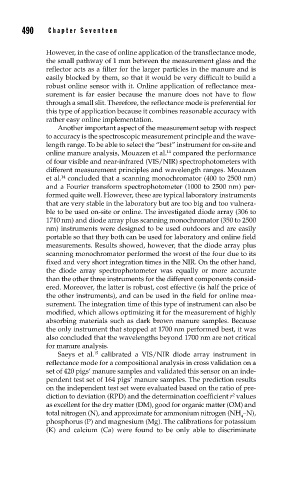Page 518 - Biosystems Engineering
P. 518
490 Cha pte r Se v e ntee n
However, in the case of online application of the transflectance mode,
the small pathway of 1 mm between the measurement glass and the
reflector acts as a filter for the larger particles in the manure and is
easily blocked by them, so that it would be very difficult to build a
robust online sensor with it. Online application of reflectance mea-
surement is far easier because the manure does not have to flow
through a small slit. Therefore, the reflectance mode is preferential for
this type of application because it combines reasonable accuracy with
rather easy online implementation.
Another important aspect of the measurement setup with respect
to accuracy is the spectroscopic measurement principle and the wave-
length range. To be able to select the “best” instrument for on-site and
14
online manure analysis, Mouazen et al. compared the performance
of four visible and near-infrared (VIS/NIR) spectrophotometers with
different measurement principles and wavelength ranges. Mouazen
14
et al. concluded that a scanning monochromator (400 to 2500 nm)
and a Fourier transform spectrophotometer (1000 to 2500 nm) per-
formed quite well. However, these are typical laboratory instruments
that are very stable in the laboratory but are too big and too vulnera-
ble to be used on-site or online. The investigated diode array (306 to
1710 nm) and diode array plus scanning monochromator (350 to 2500
nm) instruments were designed to be used outdoors and are easily
portable so that they both can be used for laboratory and online field
measurements. Results showed, however, that the diode array plus
scanning monochromator performed the worst of the four due to its
fixed and very short integration times in the NIR. On the other hand,
the diode array spectrophotometer was equally or more accurate
than the other three instruments for the different components consid-
ered. Moreover, the latter is robust, cost effective (is half the price of
the other instruments), and can be used in the field for online mea-
surement. The integration time of this type of instrument can also be
modified, which allows optimizing it for the measurement of highly
absorbing materials such as dark brown manure samples. Because
the only instrument that stopped at 1700 nm performed best, it was
also concluded that the wavelengths beyond 1700 nm are not critical
for manure analysis.
Saeys et al. calibrated a VIS/NIR diode array instrument in
15
reflectance mode for a compositional analysis in cross validation on a
set of 420 pigs’ manure samples and validated this sensor on an inde-
pendent test set of 164 pigs’ manure samples. The prediction results
on the independent test set were evaluated based on the ratio of pre-
diction to deviation (RPD) and the determination coefficient r values
2
as excellent for the dry matter (DM), good for organic matter (OM) and
total nitrogen (N), and approximate for ammonium nitrogen (NH –N),
4
phosphorus (P) and magnesium (Mg). The calibrations for potassium
(K) and calcium (Ca) were found to be only able to discriminate

